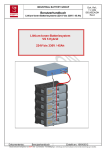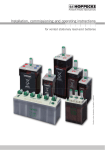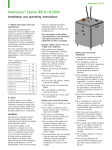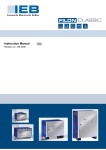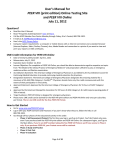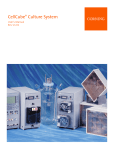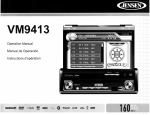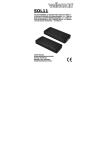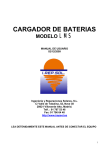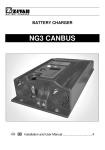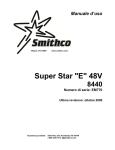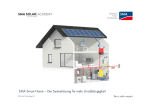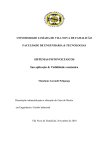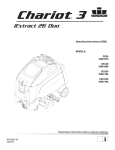Download PV Magazine (February 2013 edition) Spoilt for Choice
Transcript
Photo: Solarpraxis AG/Andreas Schlegel Storage & Smart Grids With so many technologies in the market, is there a way to say that one battery technology is better than another? Spoilt for choice Battery overview: Batteries are an integral part of the total storage solution offered for renewable energy applications. However in the selection process, comparison of the different batteries available is not easy since chemistries and performance for applications differ. This market overview shows deep cycle batteries that are on the market and the elements that can influence operation and storage. Batteries are a dime a dozen at the moment. However, good batteries for optimum renewable energy storage are another thing altogether. Selecting the wrong battery can be an expensive mistake. Renewable energy applications require deep cycle batteries, those that can discharge between 50% and 80% of storage capacity repeatedly, enabling maximum capacity and higher cycle counts. Deep cycle batteries are structurally different compared to others, like starter batteries for cars. Within the deep cycle 74 range, the chemistries vary too. Differentiating one battery type from another can be difficult making it tricky to say which is better. Alfons Westgeest, executive director of the Association of European Automotive and Industrial Battery Manufacturers (Eurobat), says: “I would say there is no clear leader in these battery technologies. Lead-based is competitive in terms of price, installation ease and maintenance. Lithium is more compact. Nickel is somewhere in between lead-based and lithium. And sodium is more for larger scale applications. They all have different characteristics.” With so many technologies on the market is there a way to say that one battery technology is better than another? How safe is my battery? Late in 2011, a sodium sulphur battery system made up of 40 battery modules went up in flames at a plant in Joso City in Japan. The battery manufacturer NGK Insulators, Ltd, had to request that cus- 02 / 2013 | www.pv-magazine.com Worldwide installed storage capacity for electrical energy as of 2010 Compressed Air Energy Storage 440 MW/3,730 MWh Sodium Sulphur Battery 316 MW/1,900 MWh Pumped Hydro 127,000 MW/~1,500,000 MWh Source: International Electrotechnical Commission Graphic: Solarpraxis AG/Harald Schütt Storage & Smart Grids Lithium Ion Battery ~70 MW/~17 MWh Lead Acid Battery ~35 MW/~70 MWh over 99 % of the total storage capacity Nickel Cadmium Battery 27 MW/6.75 MWh Flywheels <25 MW/<0.4 MWh Redox Flow Battery <3 MW/<12 MWh Sodium sulphur batteries led the pack as of 2010 but other technologies are catching up. tomers refrain from using the batteries until the cause was discovered. This affected more than 170 locations in six countries worldwide. In the middle of last year, NGK released their incident report stating that one of the 384 cells in a battery module was faulty and leaked hot molten material causing a short between battery cells in an adjoining block, and thereby causing the whole battery module to catch fire. This fire occurred in a large energy storage application and, luckily, there were no casualties. The example is not to scare people away from batteries but rather to show that the safety risks ought to be taken seriously. Batteries of all technologies are manufactured according to internationally recognized design, production and quality standards, in order to guarantee their safety for users across all applications.Potential customers must also choose carefully, with the battery selection process demanding know how. .Whoever is installing the battery needs to also know how to handle the different battery types. A market overview has to therefore cover the different parameters that need to be known. As important as safety questions are, the batteries also differentiate themselves in other factors such as capacity, cycle life, voltages and recommended charge and discharge depths among others. These parameters are therefore also found in the market overview. Eight companies participated giving details of 02 / 2013 | www.pv-magazine.com more than 50 batteries for renewable energy storage. An important factor in the aspect of safety for lithium-ion (Li-ion) batteries is the material used. Manufacturers like Leclanché indicated in the market overview that ceramic separators in their HS 3200 battery can ensure high thermal and electrical safety. Such separators have the ability to provide a shut down function in situations like a short circuit by cutting current flow. Lead- based batteries, for example, can potentially release flammable hydrogen and oxygen gases during electrolysis. Accumulation of these gases in batteries can be dangerous. In the event of sparks there can potentially be an explosion. Nevertheless this hazard can be rectified with technology. If the batteries are not valve-regulated, then they need to be placed in a well-ventilated space for safety. Hoppecke offers optional safety measures for its two vented lead-acid batteries: the AquaGen recombiner that can be fitted to all lead acid and NickelCadmium (NiCd) batteries.The hydrogen and oxygen gases that are emitted during electrolysis are fed into the AquaGen recombiner. Such situations can also be prevented with the implementation of battery management systems (BMS). Westgeest says that every battery ought to be integrated with a BMS. Having such a BMS becomes an important safety aspect especially when conditions start getting too hot or too cold for the battery. In flooded batteries, over charging means the battery will have higher water consumption and would require more maintenance. Trojan Battery’s senior applications engineer for the Renewable Energy Group Kalyan Jana adds that if this battery type is over charged over a long time in an uncontrolled-temperature environment, theoretically thermal runaway can happen. “It takes a lot but it can happen. Basically in thermal runaway the battery generates more heat than it can dissipate and it reaches a meltdown,” says Jana. Leclanché’s HS 3200, for example, has a ceramic separator in place not only for thermal but also for electrical safety and to improve the battery’s abuse tolerance. This also includes an overcharge tolerance. Saft’s product and applications manager Jésus Lugaro explains that, just as with temperature extremes, the BMS will step in when overcharging happens to a Li-ion battery. He explains: “We measure each cell voltage in the modules. This information is sent to the BMS and it has an algorithm to understand if the maximum voltage limit is reached. If so, there is a warning and the current breaker will be activated.” To Eurobat’s knowledge, there is no risk of thermal runaway during standard operation of lead-based batteries. Thermal runaway is possible in Li-based batteries because of their more volatile chemistry and higher energy density. However, Liion batteries are equipped with sophisticated battery and thermal management systems to keep their operations under safe parameters and protect against this possibility. Therefore they are also safe to operate under standard conditions. The important point for the buyer is to take note of the user manual and ensure he does not abuse his batteries and then expect them to function over many years. What temperatures can it stand? One of the fundamental aspects to look out for in a battery brochure are the operating and storage temperatures. Temperature has an influence on cycle life, an aspect we will cover later. Higher ambient temperatures tend to momentarily improve performance of the battery by lowering internal resistance and increasing the chemical metabolism. However, over a long period of time, this can affect cycle life and increase self-discharge. 75 Storage & Smart Grids At lower temperatures, internal resistance increases and decreases capacity. Temperature compensation is one feature that can help if the battery is exposed to such extremes. That is another reason why we also asked manufacturers why temperature conditions are recommended for their batteries and what kind of regulations are needed. Trojan Battery product sheets recommend an operating temperature between -20°C and 45°C for their lead-acid batteries. At temperatures below 0°C a state of charge (SOC) greater than 60% is recommended. The SOC is important for leadacid batteries in cold conditions as in a discharged state, the electrolyte becomes more water-like and freezing temperature increases. At a 40% SOC, the electrolyte can freeze if the temperature reaches approximately -8°C. Westgeest says that lithium can be a bit more sensitive to temperature extremes, adding: “It’s more sensitive to charging and decharging in particular tempera- ture curves.” The Fraunhofer Institute for Silicate Research (ISC) adds to this statement saying that even just a few degrees of temperature fluctuations can make a huge difference and this law also applies to Li-ion batteries: adding ten degrees Celsius cuts Li ion battery life in half. Saft’s lithium nickel cobalt aluminum (Li(NCA)) Synerion 24M has operating temperatures between -20°C and 60°C while storage conditions can fall to -30°C and up to 70°C. For Li-ion batteries, the BMS thus becomes the regulator. Saft’s Lugaro says that at too high or too low temperatures, the BMS will completely stop the battery at the maximum or minimum operating temperatures and no more current will be able to pass through. Applications with this battery? Apart from ensuring the temperatures the batteries are going to be stored and operated at, the buyer also has to think about the application he is going to need the batteries for. Within energy storage, there are power and energy applications, power being the rate at which energy is consumed (in Watts) and energy being the amount of power consumed (in Watt-hours). Lux Research’s Steve Minnihan explains it as an application where “you need continuous energy discharge from anywhere between five minutes and an hour”. This application relates to the socalled “big watt” household devices like coffee makers and vacuum cleaners. This calls for a battery that can charge and discharge very quickly. Energy application needs a battery that can provide energy for a longer period of time, meaning longer discharges. Minnihan explains that Li-ion batteries perform well for power applications but fall short when longer discharges are needed. Saft’s Lugaro sees it differently, stressing that it is not that Li-ion batteries are not as good as other technologies with regards to longer discharges. He says: Some deep cycle battery technologies Lead based batteries are based on lead dioxide as the active material of the positive electrode, metallic lead in a high surface area porous structure as the negative active material and a sulphuric acid solution. They consist of other sub technologies such as flooded lead acid batteries and valve regulated lead acid (VRLA). VRLA batteries, also known as sealed batteries, have electrolytes either immobilized by a gel or with the electrolyte immobilized in an absorptive glass mat or AGM. For VRLA batteries, the use of gel or glass fibers, as in the case of AGM means that they can be installed in any orientation due to the lack of liquids. VRLA batteries are relatively maintenance free but checks like voltage, internal resistance, and capacity verification measurements should be done periodically. Flooded lead acid batteries have the same internal chemistry but require upright orientation to prevent electrolyte leakage, a ventilated environment to diffuse the gases emitted when cycled and regular maintenance of the electrolyte. Lead based batteries are said to be: •• Relatively efficient but lesser than lithium ion batteries, for example •• With low self discharge rates •• Established with recycle possibilities However, they have lower energy densities, comparatively. Lithium ion batteries are based on lithium ions that move back and forth from the cathode to the anode during charge and discharge. The cathode or anode materials can differ in chem- 76 istries. The manufacturers who took part in the market overview listed lithium ion based solutions such as lithium iron phosphate (LiFePO4), lithium titanate and lithium nickel cobalt aluminum (Li(NCA)). The advantages are stated by energy expert Arup Energy Storage’s “A five minute guide to electricity storage” as: •• Extremely high energy densities •• Able to tolerate more discharge cycles than other technologies •• High efficiency Negative effects can be rectified with battery management systems. Flow batteries use two liquid electrolytes for the opposing charges which act as energy carriers. An ion selective membrane separates the electrolytes and allows selected ions to pass and complete chemical reactions during charging and discharging. Vanadium redox flow batteries use vanadium ions that are dissolved in the electrolytes in different oxidation states to store energy. Arup Energy Storage states the advantages of flow batteries as: •• Less sensitive to higher DOD •• Tolerance to a large number of charge/discharge cycles •• Reduced likelihood of cell output being reduced to that of the lowest performing cell •• Virtually unlimited capacity However, the batteries are said to have low energy densities and are not yet commercially mature. Nickel based batteries can fall into two categories, mainly: nickel metal hydride (NiMH) and nickel cadmium (NiCd). NiCd has nickel oxide hydroxide and metallic cadmium as electrodes. NiMh batteries have positive electrodes of nickel oxy hydroxide (NiOOH), like in NiCd, but negative electrodes are a hydrogen absorbing alloy instead of cadmium. Sodium nickel chloride batteries are also used in grid applications. Molten salt batteries use, as the name suggests, molten salts as an electrolyte. Sodium (Na) and sulphur (S) are the main components. The battery casing acts as the positive electrode while the molten core is the negative electrode. The battery is generally known to operate at high temperatures between 300°C and 350°C, according to Arup Energy Storage. When the batteries are not in use, they are left under charge, typically, to ensure that they remain molten and ready for use. A reheating process is needed if the battery is allowed to shut down and solidify. Arup Energy Storage defines the advantages of this battery type as: •• High energy density •• Long life cycle •• Quick response •• Efficient charge/discharge cycles •• Tolerance to high number of charge/discharge cycles. 02 / 2013 | www.pv-magazine.com Storage & Smart Grids “Lithium ion performs very well in medium to high power applications compared to other technologies. And with lower power, you still have this characteristic, but the other technologies improve when they use the low current or power. We have an added value in medium high power applications”. Lugaro adds that Saft, for example, uses a model scenario where the client decides which power and energy needs he has and then either the model M, in this case the Synerion 24M, for medium power, or E, the Synerion 48E, for energy will be proposed. How heavy is it on my pocket? Price is a very influential factor in the decision-making process for a buyer. When looking solely at capital costs, lead based batteries are seen as relatively cheaper. Lux Research’s Steve Minnihan states that on a cell level, lead acid batteries are anywhere between US$100 and US$200 per kWh. When comparing to the general costs of Li-ion or sodium nickel or even redox flow batteries, it may seem that lead acid batteries have an unbeatable price. After all Lux Research’s baseline scenario for grid-tied systems indicate that by as early as 2022 Li-ion batteries will reach US$506 per kWh storage capacity; sodium nickel chloride batteries, US$473 per kWh; and vanadium redox flow batteries (VRFBs), US$783 per kWh. Does this mean that lead based batteries have a clear advantage in terms of price? Not really. Minnihan, for example, agrees that the capital cost of lead-acid batteries is low. But he adds: “When you factor in total cost of ownership, replacement, labor and maintenance costs over a five or ten-year time frame, then the newer technologies look substantially better. “If I want an equivalent amount of energy either from a Li-ion battery or a leadacid battery, the lead-acid battery is going to be substantially larger and ancillary costs are significantly higher than a lot of analyst firms choose to admit,” Minnihan adds. He is right in pointing this out as capital cost is just one aspect. Delivery costs, site preparation and installation costs all come into play after the purchase of the battery. When we look at the table, the dimensions and weight of batteries are all differ- 02 / 2013 | www.pv-magazine.com ent and not very comparable since the capacities largely vary. But a bulkier battery can simply be interpreted with higher transport costs. This is where lead-based batteries may eventually lose out, but the eventually much lower capital cost might cancel this disadvantage out. If the buyer has a certain budget, then he ought to find out how many cycles the battery can give at a given Depth of Discharge (DOD). DOD is the capacity that the battery has been discharged to as a percentage of maximum capacity. How long can it run? The manufacturers in the list provided cycle life for DODs anywhere between 50% and 100%. Cycles for 80% DOD as well as manufacturer’s own typical specified DOD was asked for. It is not exactly a linear relationship but the deeper the DOD, the more capacity you take out and the shorter the cycle life. Deep-cycle batteries are normally not discharged 100%. This would completely empty the battery, something that is not recommended. Manufacturers normally recommend 80% DOD for Li-ion batteries, where 20% of the stored energy remains and 50% DOD for leadbased batteries. This in turn increases the service life of the battery. Trojan Battery’s Kalyan Jana says: “You could have, for example, without any specific reference, a battery that can give 1,000 cycles at 80% DOD but at 50% DOD, 1,200 to 1,300 cycles.” The buyer thus needs to take note of the DOD when looking at cycle life. The cycle life numbers may look extremely impressive, but when the buyer discharges the battery at higher DODs than that indicated, he cannot expect high cycle numbers. In other words, the real DOD limits the battery capacity. At 80% DOD, only 80% of the battery capacity is free for use. When comparing prices, it then becomes essential to look at the price for the useable battery capacity as opposed to the actual capacity. How fresh is my battery? A fresh battery is always better. Not all retail outlets that sell deep-cycle batteries periodically and dutifully recharge them. People tend to forget that batteries can self-discharge when left to sit around. The market overview table shows that up to 5% self-discharge can occur and if a battery is already six months old and has been on the shelf, it might not be at its full capacity. Hence before packing the battery into the shopping cart, check the date of manufacture. S Shamsiah Ali-Oettinger Battery glossary Actual battery capacity: According to how control electronics are programmed, the actual battery capacity varies from nominal capacity. C-rate: The C-rate shows how quickly a battery, with regards to its capacity, is discharged. 1C means the battery discharges completely within an hour. The energy available to be drawn is also dependent on the C-rate. Calendar life (when battery capacity falls to 80%): The time an inactive battery can be stored before it reaches a critical balance capacity. In our market overview, we have asked for the calendar life of an inactive battery before it reaches 80% of its initial capacity. Depth of Discharge (DOD): Expressed as %, the battery capacity that has been discharged as a percentage of maximum capacity. A discharge to at least 80% is termed a deep discharge. Efficiency of battery: Defined by two efficiencies: the coulombic efficiency and the voltage efficiency. The coulombic efficiency of a battery is the ratio of the number of charges that enter the battery during charging compared to the number that can be extracted from the battery during discharging. The voltage efficiency is determined largely by the voltage difference between the charging voltage and voltage of the battery during discharging. Energy density: A battery with higher energy density will be lighter or smaller than a similar capacity battery with a lower energy density, respectively, whether the density is given as weight (Wh/kg) or volume (Wh/l) density. This factor plays a role in the transportation cost of batteries, where a battery of higher density would be an advantage. Maximum continuous discharge current: The maximum current at which the battery can be discharged continuously. Usually defined by a manufacturer to prevent excessive discharge rates that can damage the battery or reduce its capacity. Nominal battery capacity: The amount of electrical charge that can be stored without taking into account it should not be discharged to 100%. Nominal voltage: The reference voltage of the battery. Self-discharge (%/month): The amount at which internal chemical reactions reduce the stored charge of the battery without any connection between the electrodes. State of charge (SOC): Expressed as %, the present battery capacity as a percentage of the maximum capacity. 77 Storage & Smart Grids | Market overview batteries Battery Supplies/ Crown Europe Cellstrom GmbH Accumulatorenwerke HOPPECKE 78 DE Li(NMC)* Nominal battery capacity (kWh) Maximum continuous discharge current (A) Voltage at recommended DOD (pls. provide DOD, V) Max voltage (at 100% charge) (V) Nominal voltage (V) If yes, from own production? Price (without VAT) in euros Weight (kg) Volume: HxBxD (cm) Suitable for Battery type Manufacturer Manufactured in Product Name Company neeoQube Akasol GmbH Battery controller included in delivery? Battery controller Details of battery unit General information DE 456x280x456 52 7,500 yes yes 24/48 29.4/58.8 212/106 5.5 482x482x266 49 7,150 yes yes 24/48 29.4/58.8 212/106 5.5 400 V AC(3p) 230/50 hz, 220/60 hz, 120/60 hz, MS 60036,000 25-500 Modular: 40130/200400: 400 opt. 2 2.08 *** Up to 348.8 A at 10 h discharge for OPzS solar. power 4700 Zelle (C10/10) 0.4-6.8 Akasol GmbH neeoRack DE Li(NMC)* DE Crown Solar US Crown USA Open lead acid ww 6/8/12 Solar Technologies US Crown USA Open lead acid ww 6/8/12 Solar Technologies CN Battery Supplies Gel ww 6/8/12 Solar Technologies CN Battery Supplies AGM ww 6/8/12 Solar Technologies (OPzS) EU Battery Supplies Open lead acid ww 2 Solar Technologies (OPzV) EU Battery Supplies Gel ww 2 Solar Technologies (Li ion) CN Battery Supplies LiFePO4 ww Solar Technologies (semitraction & monoblock) EU Battery Supplies Open lead acid ww Cellcube AT Cellstrom Gmbh Vanadium Redox Flow yes no Customisable 6-12 ww FB Modular: 240.5 x 220 x 465/FB 200400: 579.2 x 243.8 x 600 ww 420x105x208 815x215x580 Modular max.14T/ 200-400 60T Modular: 89,000 199,000/ 200-400: 849,000 OPzS solar. power DE Vented lead acid battery in 2 V OPzS bloc solar.power DE Vented lead acid battery in block design 6 V/12 V ww opt. 6/12 6.24/12.48 *** 1.1-1.7/ 0.6-1.7 *** 0.4-6 Accumulatorenwerke HOPPECKE 17.3-229.6 OPzV solar. power DE Sealed lead acid battery 2V ww opt. 2 2.08-2.14 OPzV bloc solar.power DE Sealed lead acid battery in block design 6V/12V ww opt. 6/12 6.24-6.42/ *** 12.48-12.84 1.2-1.8/ 0.6-1.8 solar.bloc DE Sealed AGM battery 6V/12V ww opt. 6/12 6.24-6.42/ *** 12.48-12.84 1-1.3/ 0.6-1.6 solar.power pack DE 24V system of sealed lead acid batteries in block design EU yes yes 24 24.96-25.68 *** 7.4 solar.power system DE 228-V system of sealed lead acid batteries in block design EU yes yes 228 237.12243.96 11.6 LiOn DE Lithium ion 24 29 23x1 x29 12 no *** 200 1.3 02 / 2013 | www.pv-magazine.com Market overview batteries | Storage & Smart Grids Comments Comments on battery design Other safety features Other certifications If yes, from who? External safety certificate battery ? Certificates and guarantees Specific power (W/kg) Self-discharge (%/month) Cycle life at typical specified DOD in % & C-rate (cycles) Cycle life at 80% DOD and specified C-rate (cycles) Efficiency of battery C-rate with given actual battery capacity Actual battery capacity (kWh) C-rate with given nominal battery capacity Gravimetric energy density (Wh/kg) Energy density & power Lifetime C/1 4.4 C/1 98% 3,000 (80%; C/1) 3,000 (80%; C/1) 2 105 96 yes 10-year performance guarantee C/1 4.4 C/1 98% 3,000 (80%; C/1) 3,000 (80%; C/1) 2 112 102 yes 10-year performance guarantee 80% 1,250 (80%) yes 80% 1,250 (80%) yes C/16 C/2 C/10 75% 600 (75%) yes 75% 600 (75%) yes 80% yes 75% yes 80% 2,000 (80%) yes 80% 600-1,200 (80%) yes C/16 65%-80% C/2 0.2-3.4 C/5 83% < 0.1% per Month 3 25 2329.6 yes 200700 C/10 0.55-0.85/ 0.3-0.85 C/5 83% 200700 C/10 0.2-3 C/5 83% 200700 C/10 0.6-0.9/ 0.3-0.9 C/5 83% 200700 C/10 0.5-0.65/ 0.3- 0.8 C/5 83% 200700 C/10 3.7 C/5 83% 200700 C/10 5.8 C/5 83% 200700 C/1 1.2 C/1 95% 02 / 2013 | www.pv-magazine.com 120 Typetest approval For technical data please contact export@ batterysupplies.be Non-flammable, not prone to explosion TÜV CE Norske Veritas - Plastic molded poles - Insulated HOPPECKE system connector EN 50272-2 technology for max. EN 60896-11 contact protection IEC 61427 - Optional: AquaGen recombiner - Optional: electrolyte circulation pump Vanadium Redox Flow Technology - Plastic molded poles - Insulated HOPPECKE system EN 50272-2 connector EN 60896-11 technology for max. IEC 61427 contact protection - Optional: AquaGen recombiner EN 50272-2 EN 60896-21 EN-60896-22 IEC 61427 - Plastic molded poles - Insulated HOPPECKE system connector technology for max. contact protection including battery backup unit integrated BMS and including battery backup unit UN38.3 Modular system, incl. BMS, monitor- desired capacity can be done, can be operated ing and logging as redundant system 79 Storage & Smart Grids | Market overview batteries Synerion 24M Trojan Battery Company Lithium-Titanate EU LiFePO4 EU FR/US SAFT SAFT 30x75x52 85 8,950 Nominal battery capacity (kWh) Maximum continuous discharge current (A) Voltage at recommended DOD (pls. provide DOD, V) Max voltage (at 100% charge) (V) Nominal voltage (V) If yes, from own production? Price (without VAT) in euros Weight (kg) Volume: HxBxD (cm) Suitable for Sonnenbatterie Leclanché Battery type PROSOL Invest DE Manufacturer Product Name HS 3200 Manufactured in Company Leclanché SA Battery controller included in delivery? Battery controller Details of battery unit General information 50.6 60 3.2 100-400 4.6-41 yes yes 24-48 EU, US 13.1x44.8x29.3 18.5 yes yes 24 28.1 23.128.1 160 2 yes yes 48 48.2 46.256.2 50 2.2 Lithium Nickel Cobalt Aluminium Synerion 48E FR/US EU, US 13.1x44.8x29.3 19 IND9-6V US EU 610x390x260 100 6 6.36 5.25 500 545 Ah2 IND13-6V US EU 610x568x260 143 6 6.36 5.25 500 820 Ah2 IND17-6V US EU 610x678x260 188 6 6.36 5.25 500 1090 Ah2 IND23-4V US EU 610x568x260 168 4 4.24 3.50 500 1500 Ah2 IND29-4V US EU 610x678x260 211 4 4.24 3.50 500 1910 AH2 IND27-2V US EU 610x390x260 104 2 2.12 1.75 500 1780 AH2 IND33-2V US EU 125x440x260 125 2 2.12 1.75 500 2187 AH2 T105-RE US EU 299x264x181 30 6 6.36 5.25 300 250 Ah2 L16RE-A US EU 450x295x178 52 6 6.36 5.25 300 360 AH2 L16RE-B US EU 450x295x178 54 6 6.36 5.25 300 410 AH2 L16RE-2V US EU 450x295x178 54 2 2.12 1.75 300 1235 AH2 J150 US EU 283x351x181 38 12 12.72 10.50 300 166 AH2 J185P-AC US EU 371x281x178 52 12 12.72 10.50 300 226 AH2 Flooded lead-acid J185H-AC US EU 371x381x178 58 12 12.72 10.5 300 249 AH2 T-105 US EU 276x264x181 28 6 6.36 5.25 300 250 Ah2 T-125 US EU 276x264x181 30 6 6.36 5.25 300 266 Ah2 287 AH2 T-145 US EU 295x264x181 33 6 6.36 5.25 300 J250P-AC US EU 365x295x178 44 6 6.36 5.25 300 278 AH2 J305H-AC US EU 365x295x178 45 6 6.36 5.25 300 400 AH2 L16P-AC US EU 424x295x178 52 6 6.36 5.25 300 467 AH2 483 AH2 Trojan Battery Company L16H-AC US EU 125x295x178 57 6 6.36 5.25 300 24TMX US EU 248x286x171 21 12 12.72 10.5 300 94 AH2 27TMX US EU 248x324x171 25 12 12.72 10.5 300 1172 27TMH US EU 248x324x171 28 12 12.72 10.5 300 1282 30XHS US EU 256x355x171 30 12 12.72 10.5 300 1442 U1-AGM US EU 174x207x132 12 12 12.72 10.5 300 342 22-AGM US EU 205x229x139 18 12 12.72 10.5 300 522 24-AGM US EU 220x274x174 24 12 12.72 10.5 300 842 27-AGM US EU 221x318x174 29 12 12.72 10.5 300 992 1112 VRLA AGM 31-AGM US EU 233x341x174 31 12 12.72 10.5 300 12-AGM US EU 278x345x173 45 12 12.72 10.5 300 24-GEL US EU 236x276x171 24 12 12.72 10.5 852 27-GEL US EU 234x324x171 29 12 12.72 10.5 1002 31-GEL US 5SHP-GEL US VRLA Gel EU 245x329x171 32 12 12.72 10.5 1082 EU 283x345x171 39 12 12.72 10.5 1372 8D-GEL US EU 233x534x279 71 12 12.72 10.5 2652 6V-GEL US EU 276x260x181 31 6 6.36 5.25 1982 TE35-GEL US EU 276x244x199 31 6 6.36 5.25 220 2 * Lithium Nickel Manganese Cobalt | ** Saft battery modules are operational up to 70% output capacity | *** Recommended: 50% DOD/ Voltage depends on the discharge location | depending on the discharge voltage | 1 (under Euro 80 02 / 2013 | www.pv-magazine.com Market overview batteries | Storage & Smart Grids C/1 3.2 C/1 > 90% 15,000 (100%; C/1) <3 65 C/50.7C 3.15-29 0.3C0.9C 95% 5,000 (70%; C/1) 2 100 C/5 C/5 2 C/5 95% 6,000 (C/2; 80%)** 5 104 6,500 (C/2; 70%)** 5 3.27 2 2,800 (50%) 4 30.58 4.92 2 2,800 (50%) 4 29.07 6.54 2 2,800 (50%) 4 28.75 6.00 2 2,800 (50%) 4 28.0 7.64 2 2,800 (50%) 4 27.62 3.56 2 2,800 (50%) 4 15.85 4 2.2 C/5 95% 6,000 (C/2; 80%)** 6,500 (C/2; 70%)/** 115 4.37 2 2,800 (50%) 1.50 2 1,600 (50%) 20.00 2.16 2 1,600 (50%) 24.07 2.46 2 1,600 (50%) 21.95 2.47 2 1,600 (50%) 21.86 1.99 2 1,200 (50%) 19.10 2.71 2 1,200 (50%) 19.19 2.99 2 1,200 (50%) 19.40 1.50 2 1,200 (50%) 18.67 1.60 2 1,200 (50%) 18.75 1.72 2 1,200 (50%) 19.19 1.67 2 1,200 (50%) 26.35 2.40 2 1,200 (50%) 18.75 2.80 2 1,200 (50%) 18.57 2.89 2 1,200 (50%) 19.72 1.13 2 600 (50%) 18.58 1.40 2 600 (50%) 17.86 1.54 2 600 (50%) 18.18 1.73 2 600 (50%) 0.408 2 1,000 (50%) 3 29.41 0.624 2 1,000 (50%) 3 28.85 1.01 2 1,000 (50%) 3 23.76 1.19 2 1,000 (50%) 3 24.37 1.33 2 1,000 (50%) 3 23.31 1,000 (50%) 3 1.02 2 1,000 (50%) 3 23.53 1.2 2 1,000 (50%) 3 24.17 1.3 2 1,000 (50%) 3 24.62 1.64 2 1,000 (50%) 3 23.78 3.18 2 1,000 (50%) 3 22.33 1.19 2 1,000 (50%) 3 26.05 1.32 2 1,000 (50%) 3 23.48 >100 205 131 yes TÜV Rheinland yes National Institute, ROHS, CE, SGS, Safety ventilation PONY BatCNAS tery Testing Center no external at module level, only at system level because Saft commercializes systems Batso Comments Ceramic separator EN50178 IEC60950 IP20 UN3480 IEC62093 EN50178 IEC60950 IP40 UN3480 EN61000 Comments on battery design Other safety features Other certifications If yes, from who? External safety certificate battery ? Certificates and guarantees Specific power (W/kg) Self-discharge (%/month) Cycle life at typical specified DOD in % & C-rate (cycles) Cycle life at 80% DOD and specified C-rate (cycles) Efficiency of battery C-rate with given actual battery capacity Actual battery capacity (kWh) C-rate with given nominal battery capacity Gravimetric energy density (Wh/kg) Energy density & power Lifetime SIL2 cell safety UL1642 Anode: Graphite; Cathode: LiFePO4, Dielectric: Membrane Current interrupt devices at cells, optimal thermal management, separator material, cell balancing and measurement of V,T,I in the module for module safety At system level BMS includes over-voltage, over-temperature and current protections 28.60 17.34 opean label) | ww = worldwide | opt. = optional | 2 at 100 hrs rate 02 / 2013 | www.pv-magazine.com 81









